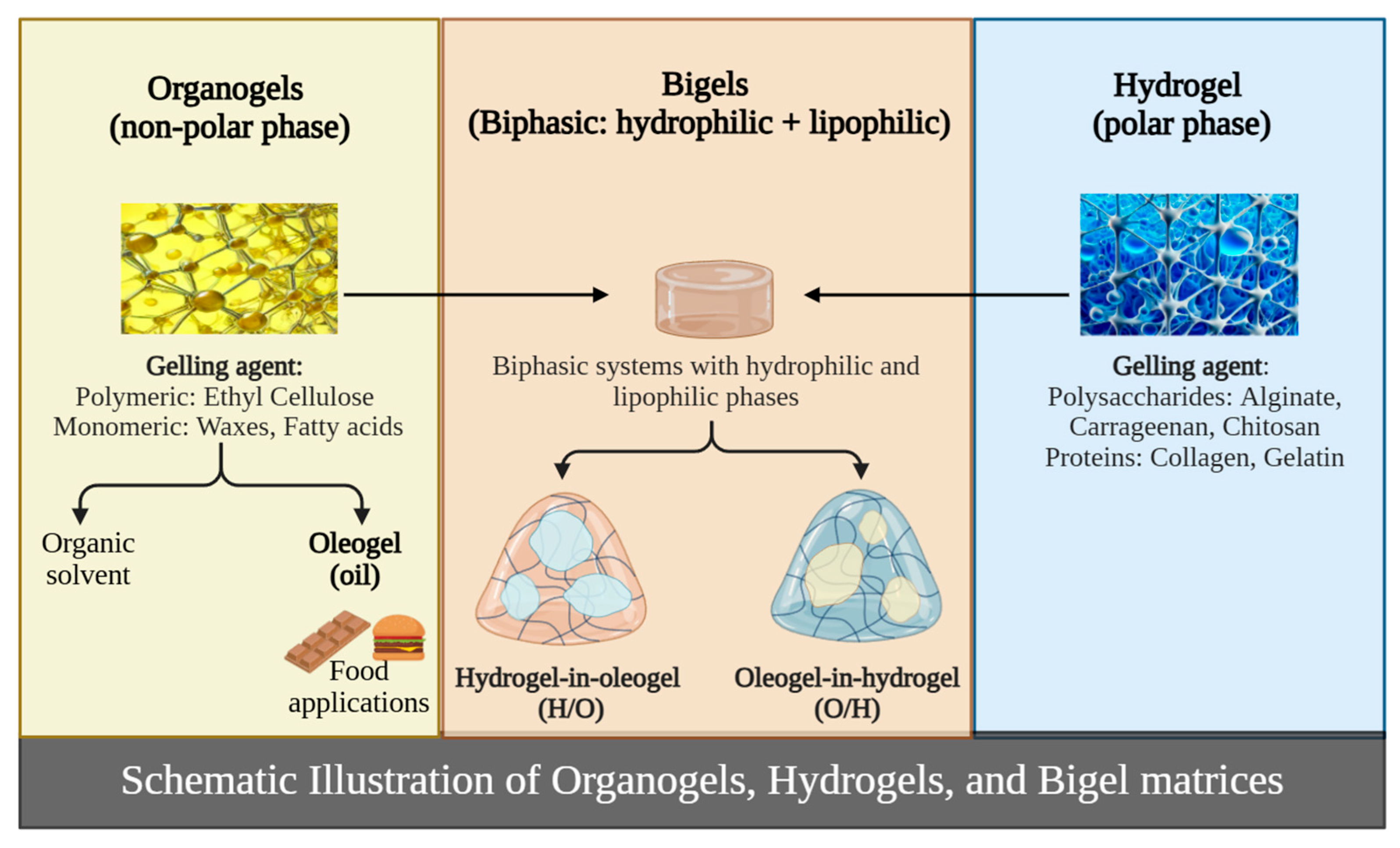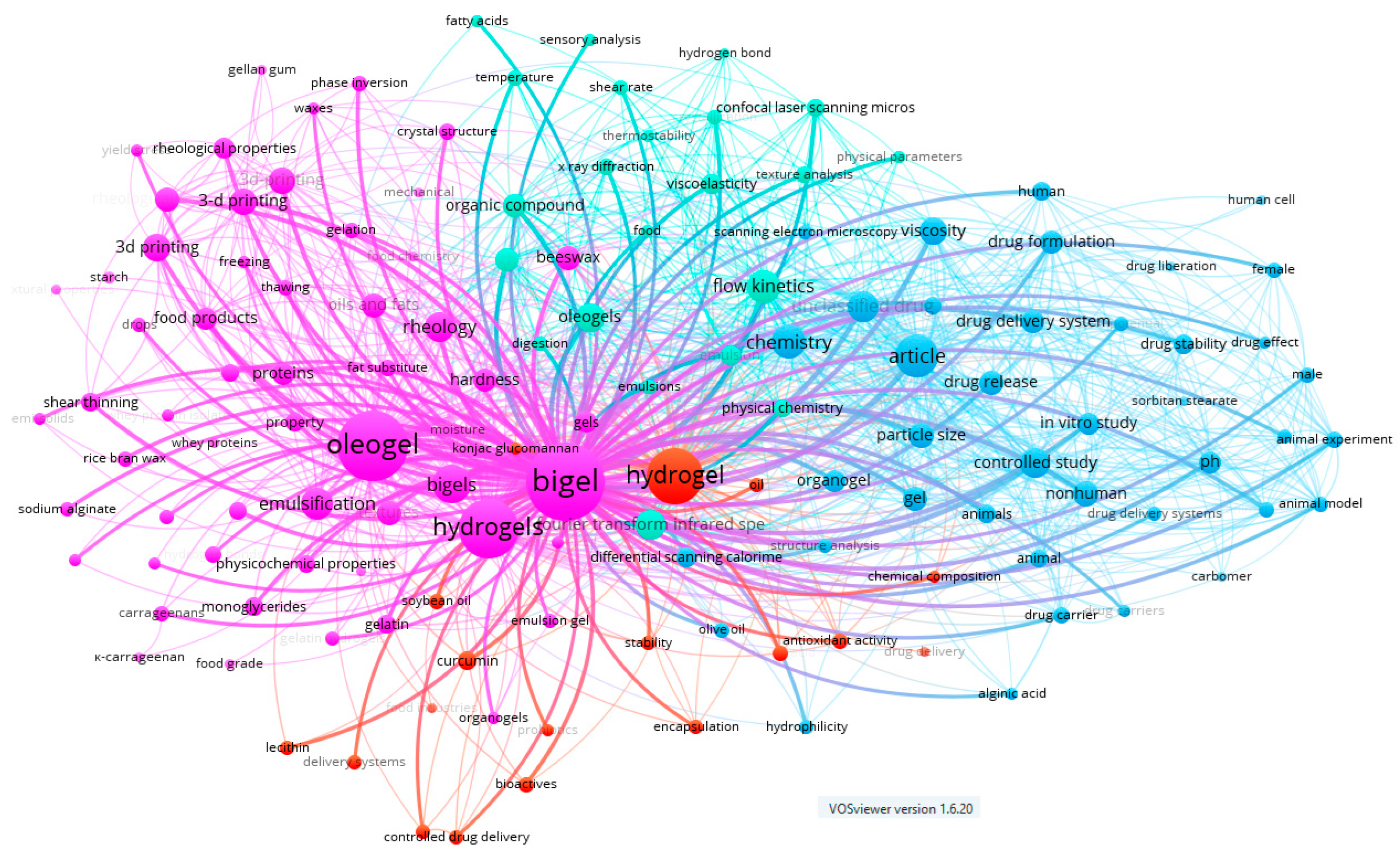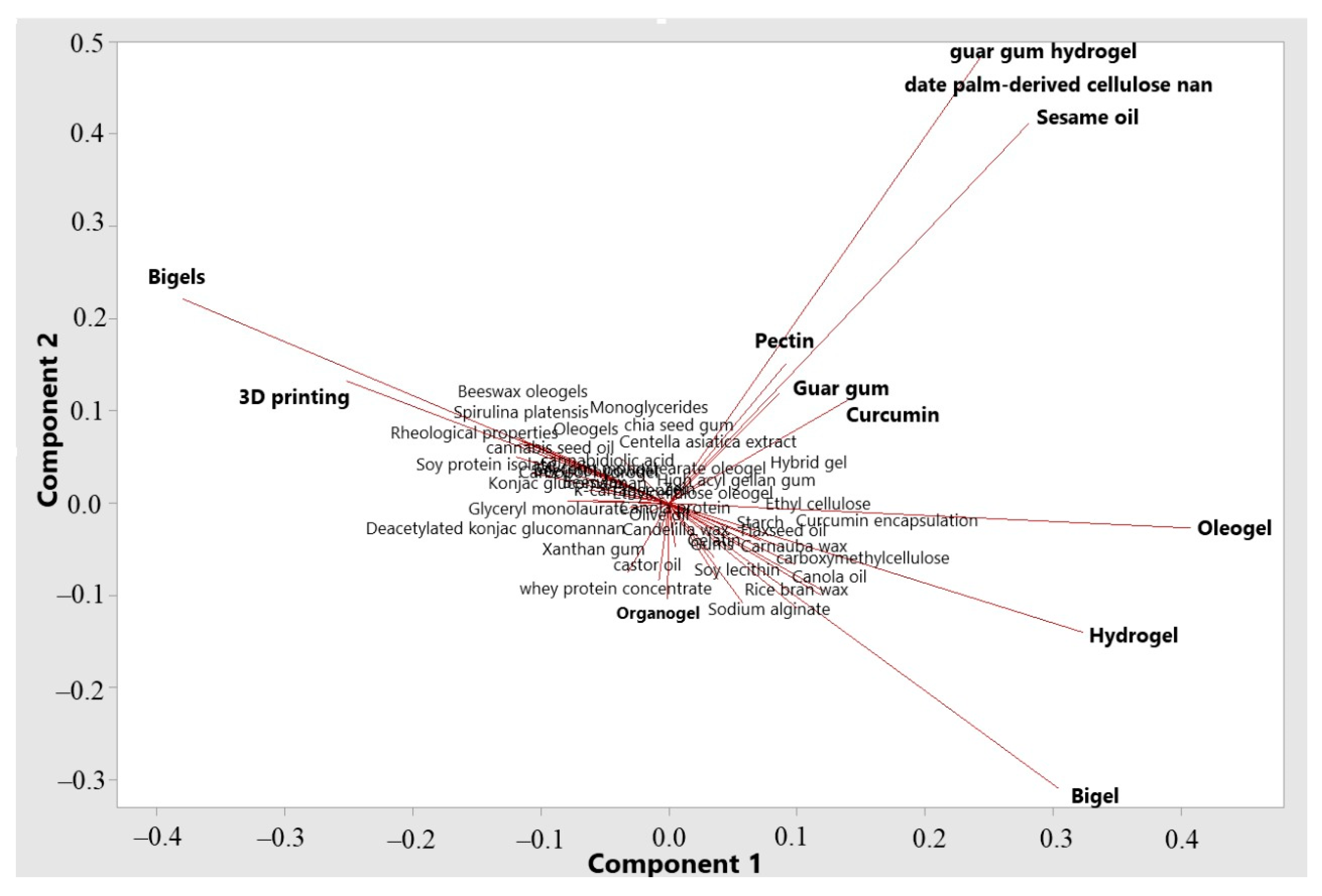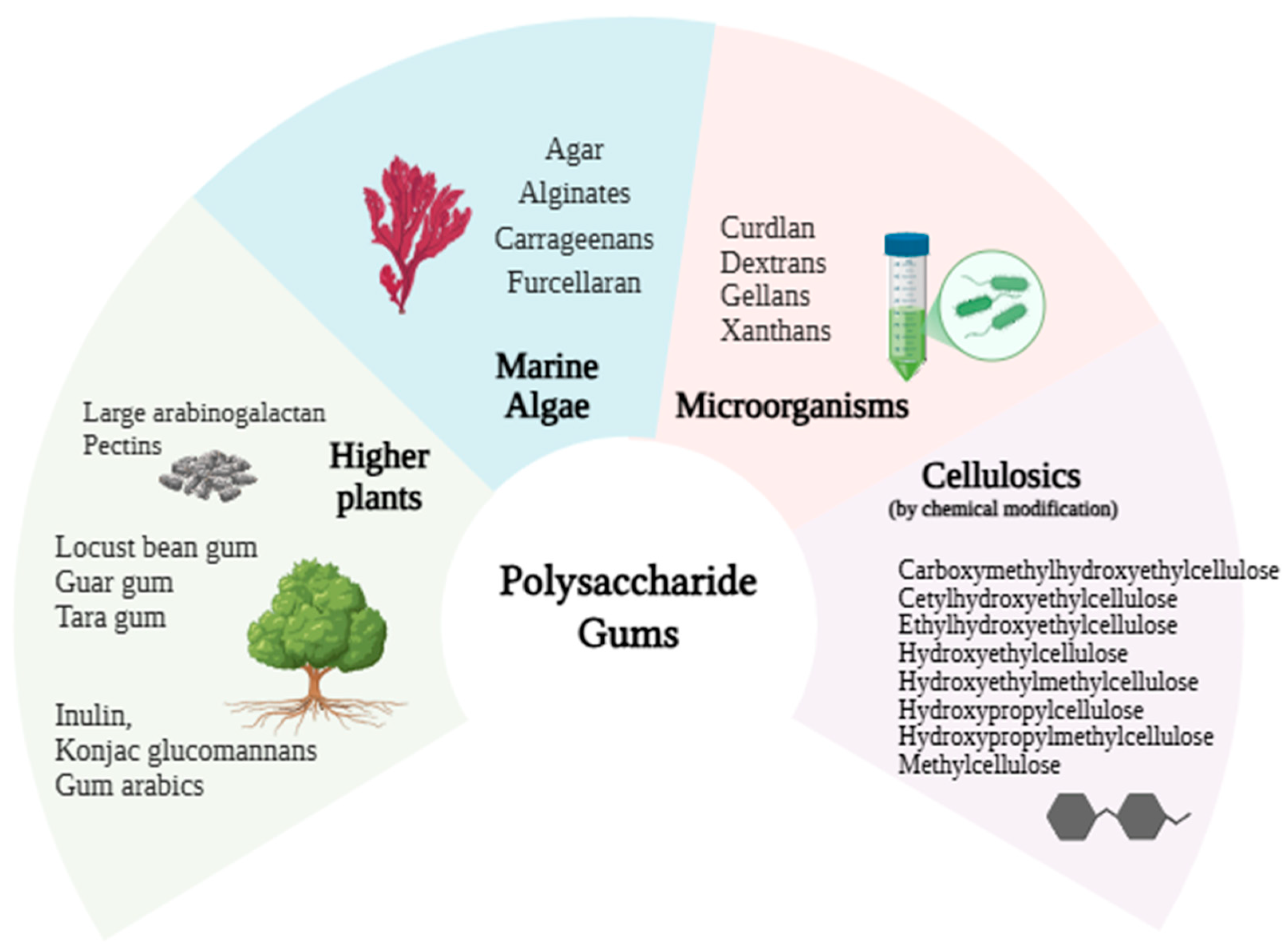Trends and Future Perspectives of Polysaccharide-Based Bigels from Seeds, Vegetable Oils, and Waxes: A Bibliometric Review
Abstract
1. Introduction
2. Results and Discussion
2.1. Bibliometric Analysis of Gels, Bigels, Oleogels and Hydrogels
2.1.1. Keyword Co-Occurrence Analysis with VOSviewer
2.1.2. Principal Component Analysis (PCA) of Keywords
2.1.3. Polysaccharides from Seeds: Emerging Sustainable Alternatives
2.1.4. New Material Developments: Bigels with Polysaccharide Gums for Improved Functionality
| Application | Bigel Ratio (Hydrogel/Oleogel) | Contributions | Ref. |
|---|---|---|---|
| Drug delivery | Sterculia gum and poly (Aam)/Olive oil and sorbitan monopalmitate): 95:5; 90:10; 85:15; 80:20; 75:25 | Bigel formulations (BG2, 90:10) can be proposed for gastrointestinal drug delivery systems due to their hemocompatible, nonhemolytic, mucoadhesive, antioxidant, and viscoelastic nature. | [27] |
| Tamarind gum (TG) with a hydroethanolic solution Stearic acid and rice bran oil: 0:30; 6:24; 18:12; 30:0 | Diffusion of the hydrophilic drug within the formulation was enhanced significantly in a composition-dependent manner as the TG hydrogel ratio was augmented (6:24, 18:12, and 30:0). | [56] | |
| Fat replacer | Locust bean gum and κ-carrageenan (1:1 ratio) at different concentrations (0.5–2.5 wt.%)/ Sunflower oil and glyceryl monostearate: 50:50; 60:40; 70:30; 80:20; 90:10 | Structural matrix elevated in formulations starting at 70 wt% of hydrogel fractions. The HG: OG ratio and biopolymer concentration (above 2 wt.%) influenced the microstructure. | [10] |
| Sodium alginate and carboxymethylcellulose Beeswax with canola oil (BW-O): 50:50 | BW-CMC presented a slightly lower peroxide value. BW-CMC and BW-ALG showed a higher transition temperature than BW-O. | [14] | |
| Xanthan gum and Guar gum/Ethylcellulose Sunflower oil: 75:25; 50:50; 25:75 | The lutein release during simulated gastrointestinal digestion was 83.2% for bigel (25:75), and the antioxidant activity was ABTS: 26.28 μg GAE/g; FRAP: 89.60 μg GAE/g. | [21] | |
| Xanthan gum (XG) Spirulina platensis protein nanoparticles (SPNPs) Sunflower wax: 80:20; 60:40; 50:50; 46:54; 44:56; 42:58; 40:40; 20:80 | Compared to bigels made of wax-based oleogel, these bigels (O/W, semi-bicontinuous, and W/O types) showed promising printability even with only 5 weight percent SW in OG. For 3D printing, semi-bicontinuous bigels with an OG fraction of 56% was appropriate. | [57] | |
| 3D printing | Beeswax: Gellan gum Oleogel: <62%; 62–68% and >70% | A protocol for directing the creation of bigels for 3D meals that have delicate shapes and modified physical characteristics. | [32] |
| Sodium alginate into a whey protein nanofiber solution/whey protein isolate -xanthan gum, corn oil emulsion: 80:20; 70:30; 40:60; 50:50 | The sensor responses of the 25% BG4 samples were nearly identical to those of the 100% cream. The textural properties of the 50% BG4 variant closely resembled 100% cream in most attributes. | [53] | |
| Agar (AH) and Gelatin (GH)/OG with 5% beeswax: 95:5; 90:10; 80:20 | 10 and 20% OGs concentrations in agar allowed the synthesis of bigels with microstructural and viscoelastic properties for printing parts with excellent surface quality, more minor dimensional deviations, and good reproducibility. | [54] | |
| Hydroxypropyl methylcellulose (HPMC) Beeswax (10%) and (1%) W/O bigels (60% and 80%) | W/O bigels with 60% oleogel content displayed great print integrity in all 3D printing procedures. TPA tests showed that the extrusion of the printing process had a strong destructive effect on W/O and semi-bicontinuous type bigels, but not on O/W bigels. | [55] |
2.1.5. Developing Oleogel/Bigel Systems Incorporating Novel Waxes and Oils
3. Conclusions
4. Materials and Methods
Author Contributions
Funding
Institutional Review Board Statement
Informed Consent Statement
Data Availability Statement
Acknowledgments
Conflicts of Interest
References
- Li, C.; Xu, Y.; Zhang, Y.; Shen, Y.; Deng, X.; Wang, F. Novel Bigels Based on Walnut Oil Oleogel and Chitosan Hydrogel: Preparation, Characterization, and Application as Food Spread. Int. J. Biol. Macromol. 2024, 260, 129530. [Google Scholar] [CrossRef] [PubMed]
- Demirkesen, I.; Mert, B. Recent Developments of Oleogel Utilizations in Bakery Products. Crit. Rev. Food Sci. Nutr. 2020, 60, 2460–2479. [Google Scholar] [CrossRef] [PubMed]
- Farzana, W.; Mahesh, S.; Sharma, S.; Syed, I.; Abdi, G.; Upadhyay, R. A Comprehensive Review on Bigels as a Potential Replacement to Solid Fat in Food Applications. J. Food Qual. 2025, 2025, 2483241. [Google Scholar] [CrossRef]
- Francavilla, A.; Corradini, M.G.; Joye, I.J. Bigels as Delivery Systems: Potential Uses and Applicability in Food. Gels 2023, 9, 648. [Google Scholar] [CrossRef] [PubMed]
- Mao, L.; Lu, Y.; Cui, M.; Miao, S.; Gao, Y. Design of Gel Structures in Water and Oil Phases for Improved Delivery of Bioactive Food Ingredients. Crit. Rev. Food Sci. Nutr. 2020, 60, 1651–1666. [Google Scholar] [CrossRef]
- Shakeel, A.; Lupi, F.R.; Gabriele, D.; Baldino, N.; De Cindio, B. Bigels: A Unique Class of Materials for Drug Delivery Applications. Soft Mater. 2018, 16, 77–93. [Google Scholar] [CrossRef]
- Pinto, T.C.; Martins, A.J.; Pastrana, L.; Pereira, M.C.; Cerqueira, M.A. Oleogel-Based Systems for the Delivery of Bioactive Compounds in Foods. Gels 2021, 7, 86. [Google Scholar] [CrossRef]
- Tofanica, B.-M.; Mikhailidi, A.; Samuil, C.; Ungureanu, O.C.; Fortună, M.E.; Ungureanu, E. Advances in Cellulose-Based Hydrogels: Current Trends and Challenges. Gels 2024, 10, 842. [Google Scholar] [CrossRef]
- Kawee-ai, A. Advancing Gel Systems with Natural Extracts: Antioxidant, Antimicrobial Applications, and Sustainable Innovations. Gels 2025, 11, 125. [Google Scholar] [CrossRef]
- Martins, A.J.; Guimarães, A.; Fuciños, P.; Sousa, P.; Venâncio, A.; Pastrana, L.M.; Cerqueira, M.A. Food-Grade Bigels: Evaluation of Hydrogel:Oleogel Ratio and Gelator Concentration on Their Physicochemical Properties. Food Hydrocoll. 2023, 143, 108893. [Google Scholar] [CrossRef]
- Hilal, A.; Florowska, A.; Wroniak, M. Binary Hydrogels: Induction Methods and Recent Application Progress as Food Matrices for Bioactive Compounds Delivery—A Bibliometric Review. Gels 2023, 9, 68. [Google Scholar] [CrossRef] [PubMed]
- Ghiasi, F.; Golmakani, M.-T. Fabrication and Characterization of a Novel Biphasic System Based on Starch and Ethylcellulose as an Alternative Fat Replacer in a Model Food System. Innov. Food Sci. Emerg. Technol. 2022, 78, 103028. [Google Scholar] [CrossRef]
- Saikia, B.; Chen, D.; De Coene, Y.; Van Cleuvenbergen, S. Organogels of FmocFF: Exploring the Solvent-Dependent Gelmorphic Behavior. Gels 2024, 10, 749. [Google Scholar] [CrossRef]
- Quilaqueo, M.; Iturra, N.; Contardo, I.; Millao, S.; Morales, E.; Rubilar, M. Food-Grade Bigels with Potential to Replace Saturated and Trans Fats in Cookies. Gels 2022, 8, 445. [Google Scholar] [CrossRef] [PubMed]
- Cao, Y.; Mezzenga, R. Design Principles of Food Gels. Nat. Food 2020, 1, 106–118. [Google Scholar] [CrossRef]
- Zheng, H.; Mao, L.; Cui, M.; Liu, J.; Gao, Y. Development of Food-Grade Bigels Based on κ-Carrageenan Hydrogel and Monoglyceride Oleogels as Carriers for β-Carotene: Roles of Oleogel Fraction. Food Hydrocoll. 2020, 105, 105855. [Google Scholar] [CrossRef]
- Gościniak, A.; Kocaj, F.; Stasiłowicz-Krzemień, A.; Szymański, M.; Karpiński, T.M.; Cielecka-Piontek, J. 3D Printed Bigel: A Novel Delivery System for Cannabidiol-Rich Hemp Extract. Gels 2024, 10, 770. [Google Scholar] [CrossRef]
- Nutter, J.; Shi, X.; Lamsal, B.; Acevedo, N.C. Designing and Characterizing Multicomponent, Plant-Based Bigels of Rice Bran Wax, Gums, and Monoglycerides. Food Hydrocoll. 2023, 138, 108425. [Google Scholar] [CrossRef]
- Hashemi, B.; Varidi, M.; Malekjani, N.; Jafari, S.M. Whey Protein-Based Bigels for Co-Encapsulation of Curcumin and Gallic Acid: Characterization, Stability and Release Kinetics. Future Foods 2024, 10, 100495. [Google Scholar] [CrossRef]
- Sun, M.; Wang, C.; Wang, H.; Tan, M. Fish Oil-Based Bigels with Outstanding Sensory and Antioxidant Properties: Application in Low-Fat Mayonnaise. Food Hydrocoll. 2025, 159, 110673. [Google Scholar] [CrossRef]
- Kaimal, A.M.; Singhal, R.S. A Bigel Based Formulation Protects Lutein Better in the Gastric Environment with Controlled Release and Antioxidant Profile than Other Gel Based Systems. Food Chem. 2023, 423, 136304. [Google Scholar] [CrossRef] [PubMed]
- Kaimal, A.M.; Singhal, R.S. Bigels for Controlled Gastric Release of Ascorbic Acid: Impact on Rheology, Texture, Thermal Stability and Antioxidant Activity. Food Hydrocoll. Health 2023, 4, 100171. [Google Scholar] [CrossRef]
- Khelifi, I.; Saada, M.; Hayouni, E.A.; Tourette, A.; Bouajila, J.; Ksouri, R. Development and Characterization of Novel Bigel-Based 1,4-Naphthoquinones for Topical Application with Antioxidant Potential. Arab. J. Sci. Eng. 2020, 45, 53–61. [Google Scholar] [CrossRef]
- Cazorla-Luna, R.; Notario-Pérez, F.; Martín-Illana, A.; Ruiz-Caro, R.; Rubio, J.; Tamayo, A.; Veiga, M.D. Bigels Based on Polyelectrolyte Complexes as Vaginal Drug Delivery Systems. Int. J. Pharm. 2025, 669, 125065. [Google Scholar] [CrossRef]
- Corredor-Chaparro, M.Y.; Vargas-Riveros, D.; Mora-Huertas, C.E. Hypromellose—Collagen Hydrogels/Sesame Oil Organogel Based Bigels as Controlled Drug Delivery Systems. J. Drug Deliv. Sci. Technol. 2022, 75, 103637. [Google Scholar] [CrossRef]
- Mukherjee, S.; Majee, S.B.; Biswas, G.R. Formulation and In Vitro Characterisation of Soybean Oil-Hpmck4m Based Bigel Matrix for Topical Drug Delivery. Int. J. Appl. Pharm. 2019, 7, 33–38. [Google Scholar] [CrossRef]
- Singh, B.; Kumar, R. Designing Biocompatible Sterile Organogel–Bigel Formulations for Drug Delivery Applications Using Green Protocol. New J. Chem. 2019, 43, 3059–3070. [Google Scholar] [CrossRef]
- Singh, B.; Mohan, M.; Kumar, R. Synthesis of Hydrocortisone Containing Dietary Fiber Almond Gum-Based Hydrogels as Sustained Drug Delivery Carriers for Use in Colon Inflammation. Food Hydrocoll. Health 2022, 2, 100057. [Google Scholar] [CrossRef]
- Soni, K.; Gour, V.; Agrawal, P.; Haider, T.; Kanwar, I.L.; Bakshi, A.; Soni, V. Carbopol-Olive Oil-Based Bigel Drug Delivery System of Doxycycline Hyclate for the Treatment of Acne. Drug Dev. Ind. Pharm. 2021, 47, 954–962. [Google Scholar] [CrossRef]
- Vergara, D.; Loza-Rodríguez, N.; Acevedo, F.; Bustamante, M.; López, O. Povidone-Iodine Loaded Bigels: Characterization and Effect as a Hand Antiseptic Agent. J. Drug Deliv. Sci. Technol. 2022, 72, 103427. [Google Scholar] [CrossRef]
- Lupi, F.R.; Shakeel, A.; Greco, V.; Oliviero Rossi, C.; Baldino, N.; Gabriele, D. A Rheological and Microstructural Characterisation of Bigels for Cosmetic and Pharmaceutical Uses. Mater. Sci. Eng. C 2016, 69, 358–365. [Google Scholar] [CrossRef]
- Guo, Z.; Chen, Z.; Meng, Z. Bigels Constructed from Hybrid Gelator Systems: Bulk Phase-Interface Stability and 3D Printing. Food Funct. 2023, 14, 5078–5089. [Google Scholar] [CrossRef] [PubMed]
- Zhai, X.; Sun, Y.; Cen, S.; Wang, X.; Zhang, J.; Yang, Z.; Li, Y.; Wang, X.; Zhou, C.; Arslan, M.; et al. Anthocyanins-Encapsulated 3D-Printable Bigels: A Colorimetric and Leaching-Resistant Volatile Amines Sensor for Intelligent Food Packaging. Food Hydrocoll. 2022, 133, 107989. [Google Scholar] [CrossRef]
- Qiu, R.; Wang, K.; Tian, H.; Liu, X.; Liu, G.; Hu, Z.; Zhao, L. Analysis on the Printability and Rheological Characteristics of Bigel Inks: Potential in 3D Food Printing. Food Hydrocoll. 2022, 129, 107675. [Google Scholar] [CrossRef]
- Andonova, V.; Peneva, P.; Georgiev, G.S.; Toncheva, V.T.; Apostolova, E.; Peychev, Z.; Dimitrova, S.; Katsarova, M.; Petrova, N.; Kassarova, M. Ketoprofen-Loaded Polymer Carriers in Bigel Formulation: An Approach to Enhancing Drug Photostability in Topical Application Forms. Int. J. Nanomed. 2017, 12, 6221–6238. [Google Scholar] [CrossRef]
- Esposito, C.L.; Kirilov, P.; Roullin, V.G. Organogels, Promising Drug Delivery Systems: An Update of State-of-the-Art and Recent Applications. J. Control. Release 2018, 271, 1–20. [Google Scholar] [CrossRef] [PubMed]
- Gao, Y.; Liu, R.; Liang, H. Food Hydrocolloids: Structure, Properties, and Applications. Foods 2024, 13, 1077. [Google Scholar] [CrossRef]
- Smith, D.K. Supramolecular Gels—A Panorama of Low-Molecular-Weight Gelators from Ancient Origins to next-Generation Technologies. Soft Matter 2024, 20, 10–70. [Google Scholar] [CrossRef]
- Hijazi, T.; Karasu, S.; Tekin-Çakmak, Z.H.; Bozkurt, F. Extraction of Natural Gum from Cold-Pressed Chia Seed, Flaxseed, and Rocket Seed Oil By-Product and Application in Low Fat Vegan Mayonnaise. Foods 2022, 11, 363. [Google Scholar] [CrossRef]
- Zhu, Q.; Gao, J.; Han, L.; Han, K.; Wei, W.; Wu, T.; Li, J.; Zhang, M. Development and Characterization of Novel Bigels Based on Monoglyceride-Beeswax Oleogel and High Acyl Gellan Gum Hydrogel for Lycopene Delivery. Food Chem. 2021, 365, 130419. [Google Scholar] [CrossRef]
- Yang, J.; Song, J.; Miao, S.; Gao, Y.; Mao, L. Alginate-Based Gel Beads with Bigel Structures: Preparation, Characterization and Bioactive Encapsulation. Food Hydrocoll. 2024, 146, 109294. [Google Scholar] [CrossRef]
- Zampouni, K.; Mouzakitis, C.K.; Lazaridou, A.; Moschakis, T.; Katsanidis, E. Physicochemical Properties and Microstructure of Bigels Formed with Gelatin and κ-Carrageenan Hydrogels and Monoglycerides in Olive Oil Oleogels. Food Hydrocoll. 2023, 140, 108636. [Google Scholar] [CrossRef]
- Akter, A.; Sobuj, M.K.A.; Islam, M.S.; Chakroborty, K.; Tasnim, N.; Ayon, M.H.; Hossain, M.F.; Rafiquzzaman, S.M. Seaweed Polysaccharides: Sources, Structure and Biomedical Applications with Special Emphasis on Antiviral Potentials. Future Foods 2024, 10, 100440. [Google Scholar] [CrossRef]
- Banerjee, S.; Bhattacharya, S. Food Gels: Gelling Process and New Applications. Crit. Rev. Food Sci. Nutr. 2012, 52, 334–346. [Google Scholar] [CrossRef]
- Alkabaa, A.S.; Akcicek, A.; Taylan, O.; Balubaid, M.; Alamoudi, M.; Gulzar, W.A.; Alidrisi, H.; Dertli, E.; Karasu, S. Production of Novel Bigels from Cold Pressed Chia Seed Oil By-Product: Application in Low-Fat Mayonnaise. Foods 2024, 13, 574. [Google Scholar] [CrossRef]
- Cui, S.W. Food Carbohydrates: Chemistry, Physical Properties, and Applications; Taylor and Francis: Hoboken, NJ, USA, 2010; ISBN 978-0-203-48528-6. [Google Scholar]
- Putro, J.N.; Soetaredjo, F.E.; Lunardi, V.B.; Irawaty, W.; Yuliana, M.; Santoso, S.P.; Puspitasari, N.; Wenten, I.G.; Ismadji, S. Polysaccharides Gums in Drug Delivery Systems: A Review. Int. J. Biol. Macromol. 2023, 253, 127020. [Google Scholar] [CrossRef]
- Fraser-Reid, B.O.; Tatsuta, K.; Thiem, J. Glycoscience: Chemistry and Chemical Biology; Springer e-books; Springer: Berlin/Heidelberg, Germany, 2008; ISBN 978-3-540-30429-6. [Google Scholar]
- Shaikh, H.M.; Anis, A.; Poulose, A.M.; Madhar, N.A.; Al-Zahrani, S.M. Development of Bigels Based on Date Palm-Derived Cellulose Nanocrystal-Reinforced Guar Gum Hydrogel and Sesame Oil/Candelilla Wax Oleogel as Delivery Vehicles for Moxifloxacin. Gels 2022, 8, 330. [Google Scholar] [CrossRef] [PubMed]
- Nishinari, K.; Takahashi, R. Interaction in Polysaccharide Solutions and Gels. Curr. Opin. Colloid Interface Sci. 2003, 8, 396–400. [Google Scholar] [CrossRef]
- Said, N.S.; Olawuyi, I.F.; Lee, W.Y. Pectin Hydrogels: Gel-Forming Behaviors, Mechanisms, and Food Applications. Gels 2023, 9, 732. [Google Scholar] [CrossRef]
- Pérez-Salas, J.L.; Moreno-Jiménez, M.R.; Rocha-Guzmán, N.E.; Rosas-Flores, W.; González-Laredo, R.F.; Medina-Torres, L.; Gallegos-Infante, J.A. Effect of Storage Time on the Mechanical and Microstructural Properties of Bigels Based on Xanthan Gum and Castor Oil. J. Am. Oil Chem. Soc. 2023, 100, 699–709. [Google Scholar] [CrossRef]
- Jiang, L.; Wang, Q.; Rao, Z.; Lei, X.; Zhao, J.; Lei, L.; Ming, J. Formulation and Characterization of Bigels Utilizing Whey Protein and Polysaccharides: Potential Applications as Cream Analogues. Food Hydrocoll. 2024, 152, 109884. [Google Scholar] [CrossRef]
- Fernandes, A.S.; Neves, B.V.; Mazzo, T.M.; Longo, E.; Jacob-Lopez, E.; Zepka, L.Q.; De Rosso, V.V. Bigels as Potential Inks for Extrusion-Based 3D Food Printing: Effect of Oleogel Fraction on Physical Characterization and Printability. Food Hydrocoll. 2023, 144, 108986. [Google Scholar] [CrossRef]
- Chen, Z.; Bian, F.; Cao, X.; Shi, Z.; Meng, Z. Novel Bigels Constructed from Oleogels and Hydrogels with Contrary Thermal Characteristics: Phase Inversion and 3D Printing Applications. Food Hydrocoll. 2023, 134, 108063. [Google Scholar] [CrossRef]
- Paul, S.R.; Qureshi, D.; Yogalakshmi, Y.; Nayak, S.K.; Singh, V.K.; Syed, I.; Sarkar, P.; Pal, K. Development of Bigels Based on Stearic Acid–Rice Bran Oil Oleogels and Tamarind Gum Hydrogels for Controlled Delivery Applications. J. Surfactants Deterg. 2018, 21, 17–29. [Google Scholar] [CrossRef]
- Guo, J.; Gu, X.; Du, L.; Meng, Z. Spirulina Platensis Protein Nanoparticle-Based Bigels: Dual Stabilization, Phase Inversion, and 3D Printing. Food Hydrocoll. 2023, 135, 108160. [Google Scholar] [CrossRef]
- Li, J.; Jia, X.; Yin, L. Hydrogel: Diversity of Structures and Applications in Food Science. Food Rev. Int. 2021, 37, 313–372. [Google Scholar] [CrossRef]
- Yang, J.; Zheng, H.; Mo, Y.; Gao, Y.; Mao, L. Structural Characterization of Hydrogel-Oleogel Biphasic Systems as Affected by Oleogelators. Food Res. Int. 2022, 158, 111536. [Google Scholar] [CrossRef]
- Martinez, R.M.; Magalhães, W.V.; Sufi, B.D.S.; Padovani, G.; Nazato, L.I.S.; Velasco, M.V.R.; Lannes, S.C.D.S.; Baby, A.R. Vitamin E-Loaded Bigels and Emulsions: Physicochemical Characterization and Potential Biological Application. Colloids Surf. B Biointerfaces 2021, 201, 111651. [Google Scholar] [CrossRef]
- Xie, D.; Hu, H.; Huang, Q.; Lu, X. Influence of Oleogel/Hydrogel Ratios and Emulsifiers on Structural and Digestion Properties of Food-Grade 3D Printed Bigels as Carriers for Quercetin and Catechin. Food Hydrocoll. 2023, 144, 108948. [Google Scholar] [CrossRef]
- Xie, D.; Hu, H.; Huang, Q.; Lu, X. Development and Characterization of Food-Grade Bigel System for 3D Printing Applications: Role of Oleogel/Hydrogel Ratios and Emulsifiers. Food Hydrocoll. 2023, 139, 108565. [Google Scholar] [CrossRef]




| Bigel (Hydrogel/Oleogel) | Applications | Aim | Key Findings (Contributions) | TC/Journal IF | Country/Year | Reference |
|---|---|---|---|---|---|---|
| Sodium Alginate and Carboxymethylcellulose/Beeswax and canola oil | Replace saturated and trans fats in cookies | Evaluate the role of hydrogel type in the development of bigels to be used as SFAs and TFAs replacers in cookies. | Bigels showed lower peroxide values than pure oleogels and canola oil, indicating improved oxidative stability and suitability as saturated fat replacers in bakery applications. | 59/5 | Chile/2022 | [14] |
| Agar/Beeswax and glyceride monooleate and sunflower oil | Sensor for intelligent food packaging | Develop a colorimetric sensor for volatile amines using anthocyanins encapsulated hydrogel-in-oleogel bigel for monitoring beef and salmon freshness. | The bigel protected anthocyanins and enabled a 3D-printed freshness sensor that changed colour (red to purple) in response to trimethylamine, indicating meat/fish spoilage. | 61/11 | China, UK/2022 | [33] |
| κ-carrageenan-xanthan gum/Beeswax and corn oil | 3D food printing | Investigate the 3D printability, rheological properties, and microstructure of bigel inks containing different concentrations of beeswax oleogel. | Increasing oleogel content improved printability, viscosity, and mechanical strength. BG5 (80% oleogel) showed the best performance for 3D food printing with strong self-support and fast recovery. | 110/11 | China/2022 | [34] |
| (High acyl gellan gum/Beeswax and Soybean Oil) | Develop bigels as a semi-solid vehicle for lycopene delivery | Fabricate novel bigels as a semi-solid vehicle for lycopene delivery | Effective bigel system for lycopene delivery; release and structure depended on oleogel content. Functional fat replacer. | 139/8.5 | China/2021 | [40] |
| Hydroxypropyl mehhylcellulose (HPMC)/Beeswax and Soybean oil | 3D food printing | Synthesize and characterize bigel systems with semi-solid properties, combining beeswax oleogels and HPMC hydrogels in varying ratios using PGPR as an emulsifier. | The W/O system (60% oleogel) showed superior mechanical and 3D printing properties. Phase inversion was observed as oleogel content increased. The system showed potential as a solid fat replacer and for customized food design. | 65/11 | China/2023 | [55] |
| Xhanthan gum/Sunflower wax and Soybean oil | 3D food printing | Examine bigel system formation through phase inversion process, varying oleogel/hydrogel ratios to enhance 3D printability and facilitate personalized food design | Spirulina platensis protein nanoparticles improved emulsion stability, phase control, and printability, enabling their use in clean-label fat replacer. | 48/11 | China/2023 | [57] |
| κ-carrageenan/Beeswax or Glycerol Monosterate and Corn oil | Novel functional products | Develop novel bi-phasic gel systems incorporating a hydrogel and an oleogel, and investigate the influence of different oleogelators on the structures of the bigels. | Higher oleogelator content increased mechanical resistance, supporting their use for bioactive delivery in food. | 48/7 | China/2022 | [59] |
| Polymeric hydrogel (not specified)/Candelilla wax vs. 12-gydroxstearic acid | Topical delivery system for vitamin E (cosmetic/pharmaceutical) | Understand the structure, rheology and stability of bigels and their corresponding emulsions in the presence of vitamin E as a model of lipophilic drug. | The oleogelator type affected the texture and thixotropy. Vitamin E had little impact on bigel stability. | 47/5.4 | Brazil/2021 | [60] |
| Fish gelatin/Candelilla wax and high oleic sunflower oil | 3D printed food systems for bioactive delivery (quercetin, catechin) | Produce 3D-printed bigels based on candelilla wax oleogel and gelatin hydrogel as a delivery system for hydrophilic and lipophilic bioactives. | Developing bigels as 3D printed food with potential in co-delivery of hydrophilic and lipophilic bioactives by adjusting oleogel/hydrogel ratios and emulsifiers used. | 46/11 | China, USA/2023 | [61] |
| Fish gelatin/Candelilla wax and high oleic sunflower oil | 3D food printing | Explore bigel applications in 3D printing by formulating food bigels using candelilla wax-based oleogel and gelatin hydrogel at varying ratios with different emulsifiers and analyzing their effects on physical properties and printability. | Bigels with monoglyceride at a 7:3 oleogel/hydrogel ratio showed the best mechanical strength and 3D printability, while PGPR caused phase separation and weak gels. | 42/11 | China, USA/2023 | [62] |
Disclaimer/Publisher’s Note: The statements, opinions and data contained in all publications are solely those of the individual author(s) and contributor(s) and not of MDPI and/or the editor(s). MDPI and/or the editor(s) disclaim responsibility for any injury to people or property resulting from any ideas, methods, instructions or products referred to in the content. |
© 2025 by the authors. Licensee MDPI, Basel, Switzerland. This article is an open access article distributed under the terms and conditions of the Creative Commons Attribution (CC BY) license (https://creativecommons.org/licenses/by/4.0/).
Share and Cite
Sanpedro-Díaz, M.; García-Hernández, A.B.; Gómez-Gómez, A.L.; Salgado-Cruz, J.; Ramos-Monroy, O.A.; Oliver-Espinoza, R.; Rivera-Vargas, G.A.; Salgado-Cruz, M.d.l.P. Trends and Future Perspectives of Polysaccharide-Based Bigels from Seeds, Vegetable Oils, and Waxes: A Bibliometric Review. Gels 2025, 11, 413. https://doi.org/10.3390/gels11060413
Sanpedro-Díaz M, García-Hernández AB, Gómez-Gómez AL, Salgado-Cruz J, Ramos-Monroy OA, Oliver-Espinoza R, Rivera-Vargas GA, Salgado-Cruz MdlP. Trends and Future Perspectives of Polysaccharide-Based Bigels from Seeds, Vegetable Oils, and Waxes: A Bibliometric Review. Gels. 2025; 11(6):413. https://doi.org/10.3390/gels11060413
Chicago/Turabian StyleSanpedro-Díaz, Monserrat, Alitzel Belem García-Hernández, Ana Luisa Gómez-Gómez, Julia Salgado-Cruz, Oswaldo Arturo Ramos-Monroy, Rubén Oliver-Espinoza, Griselda Argelia Rivera-Vargas, and Ma de la Paz Salgado-Cruz. 2025. "Trends and Future Perspectives of Polysaccharide-Based Bigels from Seeds, Vegetable Oils, and Waxes: A Bibliometric Review" Gels 11, no. 6: 413. https://doi.org/10.3390/gels11060413
APA StyleSanpedro-Díaz, M., García-Hernández, A. B., Gómez-Gómez, A. L., Salgado-Cruz, J., Ramos-Monroy, O. A., Oliver-Espinoza, R., Rivera-Vargas, G. A., & Salgado-Cruz, M. d. l. P. (2025). Trends and Future Perspectives of Polysaccharide-Based Bigels from Seeds, Vegetable Oils, and Waxes: A Bibliometric Review. Gels, 11(6), 413. https://doi.org/10.3390/gels11060413









